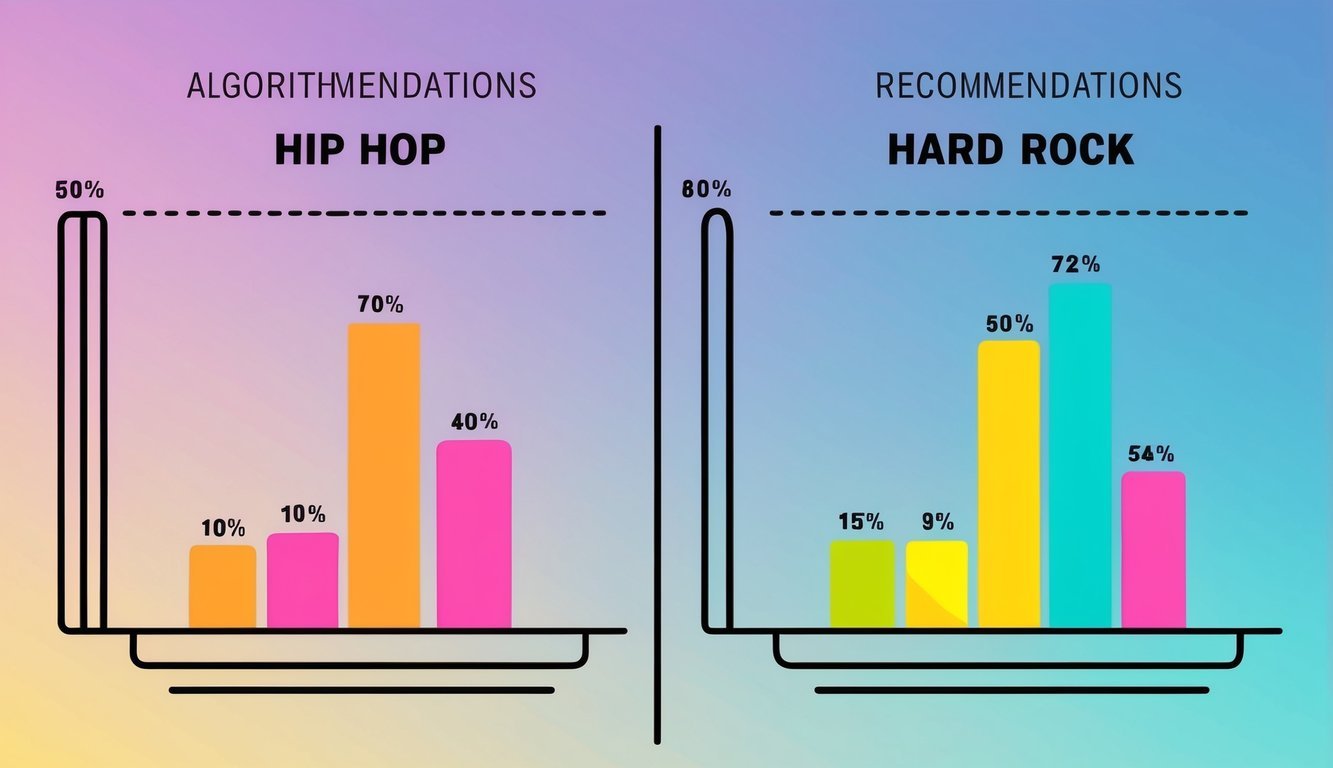Physical Address
304 North Cardinal St.
Dorchester Center, MA 02124
Physical Address
304 North Cardinal St.
Dorchester Center, MA 02124

Music streaming services have changed the way people discover new songs, but recent studies show that they aren’t perfect for everyone. Fans of hard rock and hip-hop often receive less suitable music recommendations than listeners of other genres. This can lead to frustration for those who rely on algorithms to find new favorites.
Researchers found that the energy levels of high-energy music genres pose a challenge for recommendation systems.
These systems struggle to accurately match the preferences of listeners who enjoy the intense beats and complex rhythms found in hard rock and hip-hop.
As these genres continue to grow, it highlights the need for better approaches in music recommendations.
Understanding how these algorithms work, and their limitations, can help listeners navigate their music options more effectively.
With knowledge of these shortcomings, fans can take charge of their listening experiences, seeking other ways to find the music they love.

Music recommendation algorithms play a significant role in helping listeners discover new songs.
These systems analyze user data to suggest tracks that fit individual tastes.
However, the effectiveness of these algorithms varies by music genre.
Most music recommendation systems use complex algorithms to analyze listening habits.
Companies like Spotify and Apple Music implement various methods, including collaborative filtering and content-based filtering.
Collaborative filtering looks at user behavior and preferences. It suggests music based on what similar users enjoy.
Content-based filtering analyzes the attributes of songs, such as tempo and genre, to make recommendations.
The Echo Nest, acquired by Spotify, is one example of a service that provides detailed music analysis to improve recommendations.
While these systems work well for certain genres, they face struggles with high-energy styles, like hip-hop and hard rock.
One of the main challenges of algorithmic recommendations is capturing the uniqueness of diverse genres.
Fans of hip-hop and hard rock often have specific tastes that algorithms struggle to understand.
Research indicates that listeners of these genres receive less accurate recommendations.
Factors like tempo, lyricism, and cultural context make it tough for algorithms to suggest relevant tracks.
For instance, if a listener enjoys a hard rock song, the algorithm may not find similar tracks due to heavy reliance on genre attributes.

Hip-hop is a rich and varied genre that goes beyond just music.
It encompasses a culture, unique styles, and influences on how people consume music today.
Understanding its characteristics and impact helps highlight why recommendation algorithms struggle with this genre.
Hip-hop is not just a type of music; it includes a mix of elements like rhythm, lyrics, dance, and art.
It originated in the 1970s in the South Bronx and has grown to reflect diverse experiences.
Key characteristics include:
These diverse aspects make hip-hop distinctive and deeply ingrained in various communities.
Hip-hop has significantly changed how people listen to music.
It attracts a broad audience, with its popularity soaring on streaming platforms.
Some important factors include:
These elements highlight how hip-hop continues to shape music consumption, making it an important genre in digital platforms.

Rock and hard rock music have shown strong staying power in today’s streaming landscape.
These genres maintain devoted followings despite challenges from music recommendation algorithms, which often favor popular trends over niche sounds.
Hard rock is known for its heavy guitar riffs, powerful vocals, and energetic beats.
Fans are typically passionate and loyal, often attending live shows and engaging with the music community.
This genre’s sound appeals especially to younger audiences seeking excitement and intensity in their music.
Active online forums and social media groups give fans a space to share their love for hard rock.
Many emerging artists gain traction through these platforms, bypassing traditional channels.
This connection helps create a solid fan base, ensuring the genre’s persistence in the digital age.
Rock music faces unique challenges within streaming platforms.
Algorithms often struggle to recommend rock songs effectively, especially to fans of subgenres like hard rock.
Many listeners find algorithms repetitive, only receiving suggestions based on a narrow selection of songs they’ve already played.
Despite this, rock’s rich history and variety allow it to thrive.
Playlists dedicated to classic rock, indie rock, or hard rock allow listeners to explore different aspects of the genre.
Many platforms even feature curated playlists highlighting new artists, ensuring audiences discover fresh sounds while maintaining their connection to rock music’s roots.

User behavior and preferences play a key role in shaping music selection.
This includes how mood affects choices and how recommendations influence discovering new music.
Understanding these factors can provide insight into why some algorithms struggle with certain genres.
User mood significantly influences music choices.
Different moods can lead to different selections, with people often turning to specific genres for comfort or motivation.
For example, someone feeling energetic may choose hard rock, while someone who is relaxed might prefer softer, more melodic tunes.
Platforms like Spotify use mood-based playlists to cater to varying feelings.
These playlists often feature songs that align with users’ current states.
However, when recommendations do not match the user’s mood or preferences, it can lead to frustration.
This mismatch affects how satisfying users find the app’s suggestions.
Music recommendations help users discover new artists and genres, but their effectiveness varies.
Many listeners often rely on these suggestions to explore music beyond their usual choices.
However, recommendations can sometimes repeat familiar tracks or miss out on niche genres like hip-hop and hard rock.
For example, users may receive limited suggestions based on their previous listens.
This could restrict exposure to fresh content.
When recommendations are not tailored well, it can discourage users from exploring new music.
A more nuanced understanding of user preferences, especially for less mainstream genres, can improve the quality and relevance of suggested tracks.

Recent studies show that music recommendation algorithms may struggle to effectively serve fans of genres like hip-hop and hard rock.
This has important implications for how the music industry operates, particularly in terms of audience engagement and the future of music recommendations.
The music industry needs to respond to the findings about algorithmic recommendations.
Fans of high-energy genres often feel overlooked by current systems.
To better serve these listeners, companies might:
By acknowledging audience demand, the industry can provide a more satisfying experience.
Looking ahead, algorithmic recommendations might evolve based on recent research.
As music tastes shift, the industry may focus on improving these tools.
Key areas for growth include:
With these efforts, the music industry can become more responsive and connect better with listeners, especially those who feel underserved.

Music recommendation systems often struggle with specific genres like hip hop and hard rock.
Various challenges make it difficult to provide accurate suggestions for fans of these music styles.
The following questions explore why this happens and how listeners can better find new music they love.
Music recommendation systems analyze listener behavior and preferences to suggest tracks.
For hip hop, systems may rely on popular trends and hit songs.
However, these algorithms might miss lesser-known artists or unique sub-genres, making suggestions feel repetitive.
Hard rock features diverse sounds and influences, making it tough for algorithms to categorize.
The high energy and variance in themes create complexity.
As a result, listeners may receive less relevant recommendations that don’t match their tastes.
Some platforms focus specifically on hip hop and curate lists for dedicated fans.
These systems often include community input and expert curation.
This approach helps highlight underground artists and emerging trends that mainstream algorithms might overlook.
Genres like hip hop and hard rock can be niche with varying styles.
Algorithms are often trained on data from more popular tracks, leading to gaps in suggestions.
The music characteristics and listener preferences in these genres can also be very distinct.
Improvements could include incorporating user feedback more effectively.
Enhancing data collection methods to capture diverse listening habits is crucial.
Collaboration with artists and music experts may also lead to better-targeted recommendations.
Listeners can check out curated playlists from music blogs or streaming platforms.
Social media and online communities often share hidden tracks and new releases.
Attending live shows and exploring local music scenes can also uncover fresh sounds and artists.